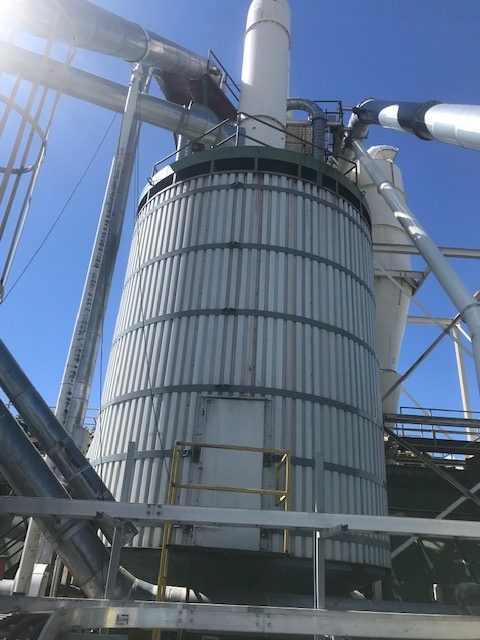
Features
Education
Health and Safety
Sawmilling
Catching lightning in a bottle
Preventing combustible dust complacency in the face of competing risk priorities
June 21, 2021 By David Murray
 Gorman Bros. Lumber’s dust extraction system. Photo courtesy Lucas Burnett, safety supervisor, Gorman Bros. Lumber.
Gorman Bros. Lumber’s dust extraction system. Photo courtesy Lucas Burnett, safety supervisor, Gorman Bros. Lumber. In the past decade, 1,604 people in B.C. have died from work-related causes and over $10 billion have been paid in claims. The No. 1 cause of occupational death in B.C. in that timeframe has been from asbestos-related diseases, with 667 workers succumbing to those. There have been 29 traumatic-type deaths in the B.C. Wood Product Manufacturing (WPM) sector since 2010, most due to workers being caught in machinery or being struck by mobile equipment. Another 1,741 WPM workers have also suffered serious injuries after being struck by or crushed against mobile equipment, and 638 have been maimed by being caught in machinery. Over a 10-year timeframe, four sawmill workers died and 42 were seriously injured in two separate 2012 sawmill combustible dust explosions. In the past 10 years, four WPM employees have died and 597 seriously injured due to falls from height. In the last decade, 112 WPM workers have died after being exposed to asbestos at work, and since 2020, the WPM sector, B.C. and the world have been overwhelmed by a global COVID-19 pandemic that has caused almost four million worldwide fatalities.
It is easy to miss that sandwiched in between all of these terrible statistics were those of the tragic 2012 B.C. sawmill dust explosions. If this is an article about combustible dust, why start it out with a “Where’s Waldo” search exercise for that topic? Simply put, to hint at why high severity but latent hazards can be destined to fall off the radar. Fortunately, there are ways to catch lightning in a bottle and maintain control over these types of risks, and this article will discuss some of these complacency-busting tips.

David Murray, corporate safety, HR and environment manager, Gorman Group, and chairperson of the Manufacturing Advisory Group. Photo courtesy David Murray.
Before learning how to address complacency towards combustible dust risk, it is important to understand how safety risks get managed. Famed economist Lord Lionel Robbins defined his specialty as, “the science which studies human behaviour as a relationship between ends and scarce means which have alternative uses.” There is a strong correlation to that definition of economics and how many safety professionals manage risk. Using economic principles to analyze the laundry list of tragedy above through a safety lens may help us decide where to place the “scarce means” that are available to tackle each “end”. Shouldn’t money and effort be prioritized towards the largest cause of occupational death? If so, we ought to drop what we’re doing and focus on preventing asbestos exposures in businesses. How about the injuries that cost the most financially? Those would be overexertion and musculoskeletal injuries, which would mean safety programs need to spend a lot more time on ergonomic control measures.
[Editor’s note: This article is part of Dust Safety Week 2021. Find more articles here.]
Two B.C. WPM safety groups, the B.C. Forest Safety Council (BCFSC) and the Manufacturing Advisory Group (MAG), have chosen a traumatic injury prevention mandate that centres around a Serious Injury and Fatality potential (SIFp) initiative. Regarding that mission, the statistics suggest these safety groups should focus on preventing workers from being caught inside live machinery and from being struck by mobile equipment or spilled loads. Those are indeed categories that are on the short SIFp priority list, but it may come as a surprise that so, too, is combustible dust. The following complacency-busting tips will explain how and why the BCFSC and MAG are ensuring the insidious dust hazard remains targeted and B.C. WPM businesses are continuing to effectively safeguard against the risk of combustible dust explosions.
Complacency-busting tip #1: Climb and stay at the top of the hazard control hierarchy
It may sound like a boring tip, but the most effective, fundamental practices often are. The hazard control hierarchy order of elimination, engineering, administrative, and personal protective equipment (PPE) has been historically used to control wood dust risks in the inverse order. Rules requiring workers to wear gloves and safety eyewear served to protect against slivers and dust in eyes, and almost every worker in the WPM industry started their career wielding a shovel to clean-up sawdust, an example of an administrative control. In the 2012 sawmill explosions, the first control measure that was ramped up across the B.C. industry was an increase in manual sawdust clean-up. Because of the substantial cost and sophistication required, engineered control measures such as dust extraction systems and baghouses were slower to be expanded upon, but, over time, this has happened. The number of manual clean-up workers can change over time and, therefore, so too can that administrative control measure’s effectiveness. Although a more costly upfront investment, a maintained engineered dust control system pays the business back in peace of mind, knowing the combustible dust risk is comprehensively addressed.
Complacency-busting tip #2: Keep honest by adopting and maintaining an audit cycle
No matter which control measures a business chooses in their combustible dust safety program, it is important to confirm that they have adequately addressed the risk now and over time. Another unexciting but most effective way to confirm this is through a tailored dust audit, and ensuring that that audit’s cycle is maintained. The BCFSC/MAG combustible dust audit does just that – and this can be utilized as a standalone audit or included under the broader MAG-SAFE audit.
Complacency-busting tip #3: Catch lightning in a bottle and don’t lose momentum
This tip is about reaching people’s hearts. In 2012, the deaths and injuries caused by the two mill explosions affected our B.C. industry differently – these were people from our industry family who suffered in a catastrophe unique to our sector. The long-term statistics may not have met a threshold that typically drives our actions, but our reaction then was to never forget this tragic year and our behaviours today demonstrate that we haven’t and we won’t. Our industry safety groups continue to keep combustible dust as a priority, our WPM businesses maintain what is required to prevent a reoccurrence, and we honour those lost and injured in 2012 with commemorations like the annual Dust Safety Week.
A former colleague of mine had a personal reason that drove him to campaign for charitable funding towards a specific disease, and he was quite accomplished in his efforts. One thing that he attributed to his fundraising success is the idea that although all charities exist for great causes, they are like businesses – each competes against others for every scarce dollar. My take-away from that was how good business practices can solve problems; they can help one charity raise more money than another, or, in our case, help address a seemingly impossible safety challenge. What may be missed in the technical economics approach mentioned at the beginning of the article is how critical it is to also connect emotionally with these issues – it’s that emotional tie to combustible dust that has caused our industry to catch lightning in a bottle and not let it go.
References
- Industry health and safety data. WorkSafeB.C.. (2020, December 9). www.worksafeB.C..com/en/about-us/shared-data/interactive-tools/industry-health-safety-data
- Robbins, L. (1984). An Essay on the Nature and Significance of Economic Science. doi.org/10.1007/978-1-349-17510-9
- Combustible Dust Safety. B.C. Forest Safety Council iCal. (n.d.). www.B.C.forestsafe.org/combustible-dust-safety/
David Murray, CRSP, is the corporate safety, HR and environment manager for Gorman Group and chairperson of the Manufacturing Advisory Group.
Print this page